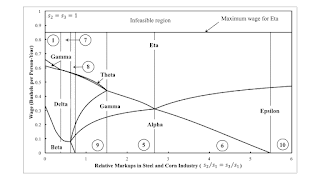1.0 Introduction
I have previously considered
some
points
on which Marx is vulnerable. In this post, I mention three mistakes.
I take the first from Joan Robinson and probably the second point too.
I take the third from Ajit Sinha. The second is perhaps the least original.
You can find lots of stupid stuff and nonsense about Marx. Pointing
out these particular mistakes is
beyond many. To have an opinion about these points, one must
read Marx. One might even accept that Marx is mistaken on these
points, yet find his general vision correct.
2.0 The Rate of Profits in Volume 1 of Capital
Marx defines the rate of profits in his system of labor
values as:
r = s/(c + v)
where c is constant capital, v is variable capital,
and s is surplus value. All are measured in value.
Some components of constant capital consist of long-lived machinery.
Marx says the value of output is (c + v + s).
In this expression, constant capital cannot be the total value
of the capital stock. It makes most sense to think of c
here as the value of capital used up in a given period.
If a machine lasts ten years, it passes approximately 1/10th of its value
into the output produced each year. That is, c is a flow.
(This is an approximation. One should resist the urge to think of
depreciation as solely a matter of physical deterioration of capital
goods.)
But, in the formula for the rate of profits, c is a stock.
See appendix below. Marx uses the same variable, c, for a stock and
a flow. This, at least, risks confusion.
3.0 The Law of the Tendency of the Rate of Profits to Fall
One can also write the rate of profits in the system of labor values as:
r = (s/v)/((c/v) + 1) = e/(1 + occ)
where e is the rate of exploitation (also known as the rate of surplus value)
and occ is the organic composition of capital.
Marx was famously concerned with "the laws of motion" of the capitalist mode of
production. In particular, he thought that technical progress, under capitalism,
leads to an increase in the organic composition of capital. This supposed
trend has been called Marx-biased or capital-using technical change.
If the rate of exploitation stays the same, the tendency of the rate of
profits to fall follows from the above formula.
(One might note that under these assumptions, a constant rate of exploitation
with a constant length of the working day implies that wages consist of
more commodities, even if they embody a constant quantity of labor time.
This is a difficulty in reading Ricardo. He would refer to this as a case
of constant "real" wages, while the overwhelming number of economists these
days would say real wages have increased.)
Anyways, I raise the question about technical progress in industries
producing capital goods. Even if the physical quantities of capital
goods with which laborers work is increased by technical progress,
the ratio of the value of those capital goods to labor time
need not rise. So I do not see that one must expect the organic
composition of capital to increase.
A related problem with the above formula was exposed by the Okishio theorem.
To be fair to Marx, his claim about the law of the tendency of the rate of profits to fall
is in volume 3, which was assembled out of his notes by Engels and not published in his
lifetime. Also, he explicitly notes countervailing tendencies, including the
cheapening of means of production by technical change in Department I.
4.0 Extra Profits Made from Innovations
Marx argues that the source
of
income
to property (profit, interest, rent, etc.)
is value added by workers not paid out in wages. At any point in time, market
prices deviate from prices of production and some make value on alienation,
while others lose. So abstract from these deviations and assume prices
of production prevail.
Even so, some businesses will be introducing new process of production, in
which they can make excess profits. Eventually, one expects these excess
profits to be wiped out, as other capitalists adopt these new processes
and prices of production vary accordingly.
But suppose innovation becomes a regular business, as it now is in
Research and Development departments at many businesses. So innovation
becomes a regular source of (fluctuating) profits that is not
gained from exploiting the worker.
Appendix: Derivation of Straight-Line Depreciation
Consider a production process that produces g widgets from
inputs of m long-lasting machines, a units of commodity A,
b units of commodity B, and so on, to k units of commodty K.
This production process also requires inputs of l person-years of labor.
The machine lasts n years. (This example is from chapter X
of Sraffa (1960).)
Consider an annuity that costs pM dollars now and pays out
x dollars at the end of each of n years. The interest rate r
that equates the price of the annuity to the present value of the payments is such that:
pM = x/(1 + r) + x/(1 + r)2 + ... + x/(1 + r)n
Or:
x = pM r(1 + r)n/[(1 + r)n - 1]
For a small positive rate of profits:
(1 + r)n ≈ 1 + n r
Thus, the annual annuity is approximately:
x ≈ pM[(1/n) + r]
Buying a machine is like buying an annuity. For this special case, the following equation enters Sraffa's system of price equaitions:
pM m(δ + r) + (pAa + ... + pK)(1 + r) + lw ≈ pGg
where:
δ = 1/n
The rate of profits is charged against the value of the entire stock of capital, not merely the value of the flow of used-up capital goods in a single year.








